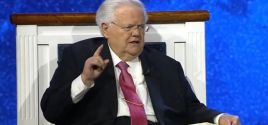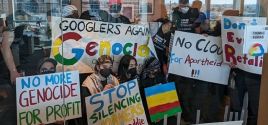Speaker to detail Masonic mystery: What happened to William Morgan in Canandaigua in 1826?Rochester Democrat and ChronicleSep. 14, 2005 |
Popular 
Report: Blinken Sitting On Staff Recommendations to Sanction Israeli Military Units Linked to Killings or Rapes

America Last: House Bill Provides $26B for Israel, $61B for Ukraine and Zero to Secure U.S. Border

Bari Weiss' Free Speech Martyr Uri Berliner Wants FBI and Police to Spy on Pro-Palestine Activists

John Hagee Cheers Israel-Iran Battle as 'Gog and Magog War,' Will Lobby Congress Not to Deescalate

'Woke' Google Fires 28 Employees Who Protested Gaza Genocide
 (September 12, 2005) — CANANDAIGUA — The mysterious disappearance of mob-linked union leader Jimmy Hoffa in 1975 continues to baffle authorities and inspire conspiracy theories. But Hoffa's disappearance 30 years ago is a relatively recent event compared with the strange case of William Morgan, who vanished — like Hoffa, without a trace — after being bailed out of jail in Canandaigua by members of a local Masonic lodge 179 years ago today, Sept. 12, 1826. The story of Morgan's disappearance "remains touchy stuff — to this day," said Kathleen Kutolowski, chairwoman of the history department at the State University College at Brockport. She will lecture Sept. 22 at the Ontario County Historical Society on the role of Freemasonry in Morgan's mysterious abduction and disappearance. Morgan's abduction gave rise to the nation's first-ever third political party — the Antimasons — and ultimately reshaped the U.S. political landscape. "The American public came to feel that the incident — and resulting feckless efforts to prosecute Morgan's suspected killers — was part of a widespread conspiracy to thwart justice, in the same way that some people viewed the Watergate incident as a high-level cover-up and denial of justice," she said. According to historical accounts based on police and news reports of the era, Morgan was targeted by the secret society — whose members included such U.S. heroes as George Washington and Benjamin Franklin — when he conspired with a Batavia newspaper publisher, David Miller, to publish a book describing the Masons' clandestine rituals, signs and signals. In a misguided effort to derail the book, Miller's printing shop was set ablaze and Morgan was arrested on Sept. 11, 1826, after being falsely charged with stealing a collar and tie from a prominent Masonic merchant. Although the theft charge was dismissed, he was ordered held at the Ontario County Jail after his accusers complained that he owed a bar bill of $2.69. After spending one night in jail, Morgan was last seen being ushered into a horse-drawn carriage during the evening hours by a group of local Masons who had paid his modest debt and bailed him out. According to historical accounts, Morgan struggled with his abductors and cried out "Murder!" before the carriage clattered westward and disappeared into the night. "He was never seen again, and no body was ever found," Kutolowski said. Morgan's controversial — and by most accounts accurate — book exposing secret Masonic rituals was published after his disappearance and presumed death at the hands of members of the fraternal group he had once tried to join. Though a murder conspiracy was never proved, the mystery sparked widespread criticism of the Masons, whose members represented upper levels of society in our fledgling democratic nation. Richard Fletcher, executive secretary of the Masonic Information Center in Silver Spring, Md., said the Morgan affair "did enormous damage to the fraternity at the time, especially in the Northeast. ... It's part of our history." The Masons were blamed even though there was never any evidence of conspiracy and "nobody knows what really and truly happened," Fletcher said. "The man disappeared. He simply disappeared and was never seen again except like Elvis sightings — unconfirmed reports that different people saw him in different locations." Regardless of what happened to Morgan, Kutolowski said, the fraternal organization continued to thrive and after an initial backlash, Freemasonry lodges throughout the country continued to attract members from among the most productive levels of society. "In Warsaw, Batavia, Avon, Canandaigua, Le Roy and many other western New York communities, the Freemasons individually were very important contributors" to commerce and society, she said. "Their values resonated very well with the values of the early Republic." Today, Masonic lodges are among the groups most eager to hear her lecture on the unsolved William Morgan mystery. The Antimason group that was spawned by the incident evolved into other political movements — some of which merged into what is known today as the Republican Party. "The Freemasonry movement was a major pillar of early American community life that wanted settled, stable communities," said Kutolowski. |



